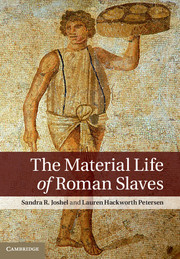Chapter 4 - Slaves in the Workshop
Published online by Cambridge University Press: 05 November 2014
Summary
If the following clause is written in a will, “I give and legate those things which were made and acquired to equip and carry on the business of my shops, mill, and inn,” Servius replied that by these words both the horses which were in the mill and the millers, and in the inn the slave managers and the cook, and the merchandise in these establishments, were regarded as legated.
—Digest 33.7.15 (trans. a. watson)Walking north along Via Stabiana in Pompeii, visitors pass one rectangular space after another (Fig. 88). Identified as shops or workshops, these spaces appear as variations on a theme: the one or two rooms have rubble or gravel floors and unpainted walls; wide front doorways open directly on the sidewalk or street, their thresholds grooved for wooden shutters. Most often, it should be said, we bypass these places – after all, they appear empty. The same experience could be repeated on other streets in both Pompeii and Ostia. Yet in many of these rooms slaves worked, ate, slept, and led their daily lives. Their workplaces remain, yet they seem invisible now that the tools, tables, and shop signs are long gone. In a few cases, however, distinctive features leave traces of workers’ activities in the archaeological landscape: mills and ovens clearly indicate ancient bakeries, and stalls and basins, fulleries. These features allow us to do what is impossible for the myriad empty shops and workshops – examine the material life of Roman workers in the ancient city. Since our concern is with slave workers, we focus on one of the identifiable urban workshops, the bakery, where literature and law testify to the certain presence of slaves. At key points the chapter turns briefly to fulleries to explore the conditions of laboring for slaves in the city and to highlight aspects of reading the archaeological record.
- Type
- Chapter
- Information
- The Material Life of Roman Slaves , pp. 118 - 161Publisher: Cambridge University PressPrint publication year: 2014



